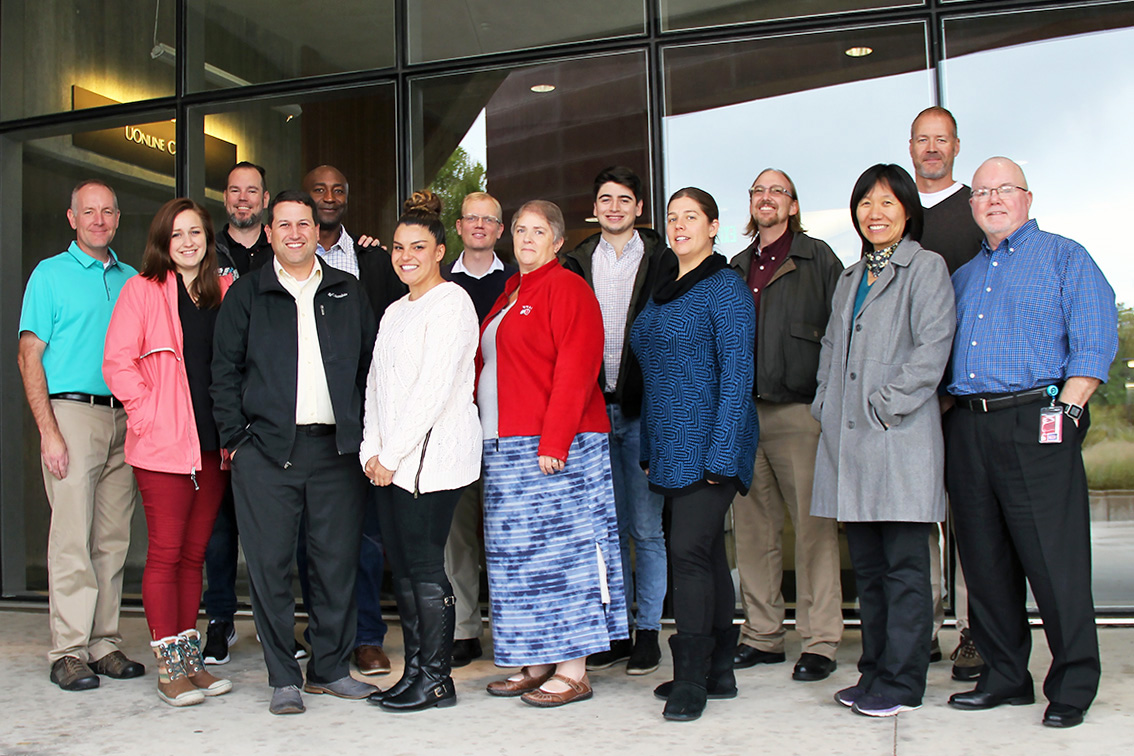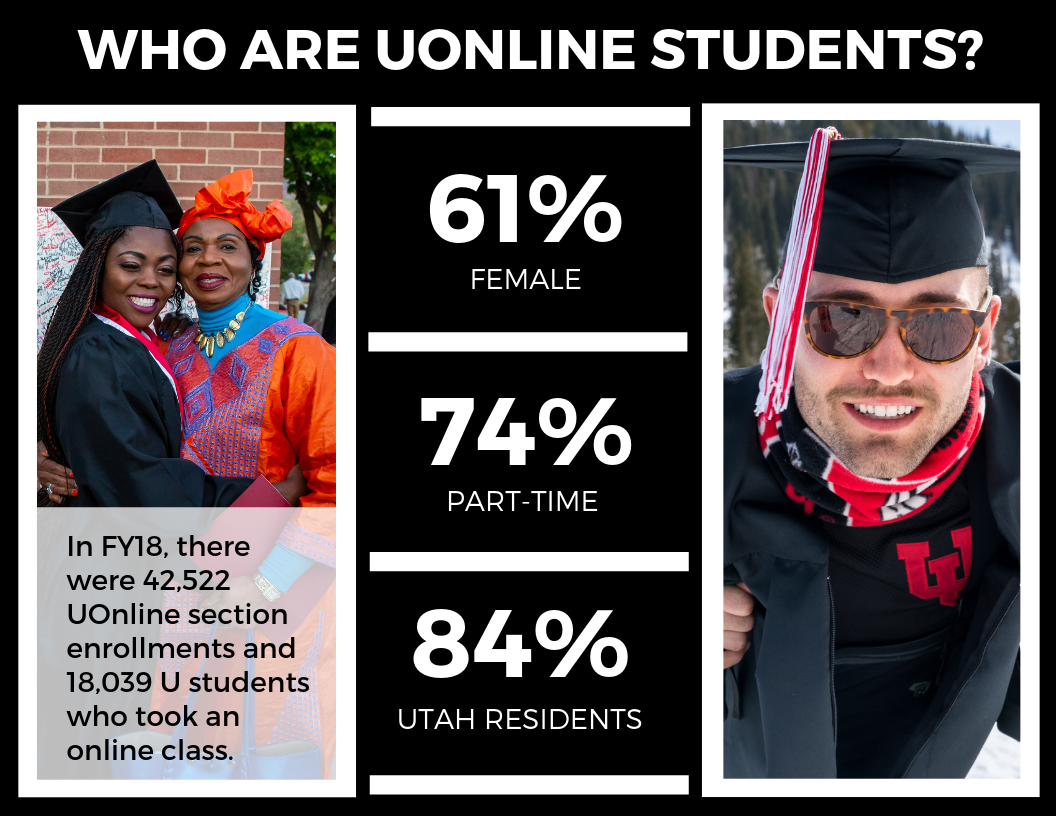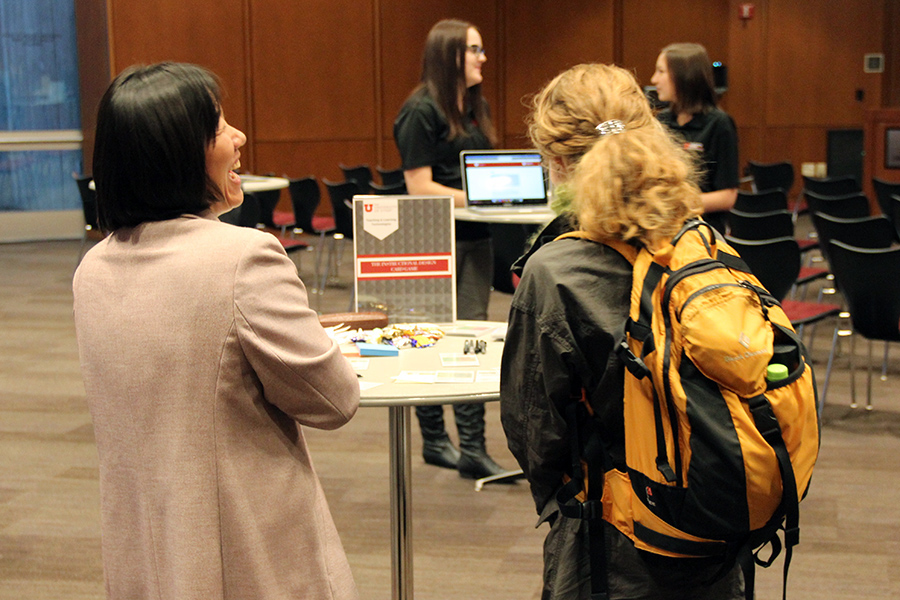You’re accessing archived content
This is archived content from the UIT website. Information may be outdated, and links may no longer function. Please contact stratcomm@it.utah.edu if you have any questions about archived content.
Meet Your Colleagues: UOnline Team, Teaching & Learning Technologies

L-R: Erik Hjorten, Lyndi Duff, Chris Hoffman, Jon Thomas, Daniel Gowon, Jasmine Harris, Nate Sanders, Rebekah Grow, Emerson Pratt, Amanda Babcock, Cory Stokes, Qin Li, Stan Clements, and Paul Burrows. Not pictured: Cecile Paskett, Jeffery Hullinger, and support staff members Cindy Hanson and Jeanne Krogen.
It's never easy to concede that what worked in the past may not anymore.
For longtime instructors, this often means not teaching exclusively via PowerPoint, abandoning the idea that online learning doesn't meet the standards of in-person instruction, or letting go of the notion that virtual classrooms hamper rather than heighten interaction with students.
Enter the UOnline team, whose job is to alleviate such concerns – especially feelings of technical inadequacy. The group, a unique partnering of academic and IT support located in the Marriott Library Faculty Center, supports all curriculum at the U — whether online, traditional, or hybrid (a combination on-campus and online courses).
The team turns anxious instructors into confident online teachers. Part of their collective role is to reassure faculty members that they’re supported by a gifted team of instructional designers, software product managers, videographers and other multimedia specialists.
"We’re trying to push faculty to look beyond the traditional PowerPoint delivery method, and leverage what online is best at," said Nate Sanders, instructional design manager and Canvas administrator.
The team may, for example, offer an alternative technology like Adobe Spark, free to the U community through a campus agreement with Adobe for Creative Cloud, which Instructional Designer Daniel Gowon playfully calls, "PowerPoint on steroids."
"The learning curve is seriously 10 minutes. That's all it takes to learn how to create a great-looking web story,” Gowan said.
Instructional designers are backed up by TLT's Video Services team, who have access to a full-service studio. Working with faculty and media team members, they conceptualize, plan and direct media projects that go into the classes — typically lecture videos — but may also include things like role-play videos and special field shoots.
Instructional Designer Cecile Paskett described a recent trip to Hogle Zoo where they filmed a sequence on primate behavior for an instructor was also an anthropological primatologist. In one instance, Sanders said, they created a homeland security simulation, in another, they filmed a professional photographer setting up lights for a photography course. In general, it takes about 6 months to fully design an online course, though consultations allow them to add new online elements throughout a term.
Online coursework, faculty soon discover, is sophisticated and pedagogically-engaging. There's a research component, as well.

Source: Fiscal Year 2018 Annual Report (Student data snapshots, spring semester '18), prepared by U Curriculum Management,
UOnline, and UIT's Teaching & Learning Technologies. Images courtesy of the University of Utah.
"During development, there is a feedback loop [with instructors and students] about pedagogy problems, which we build in, and make continuous improvements," said Senior Instructional Designer Qin Li. "Being part of this, faculty start to open up their minds to see what's possible, more interesting, and engaging," noting that she sometimes uses an instructional design card game to illustrate the process.
"Faculty tell me that coming in here and going through the course design process changes the way they teach — both online and in their classrooms on campus," said Cory Stokes, Digital Learning Officer and associate dean of Undergraduate Studies. “It's a real eye opener."
Teaching and learning, as it turns out, is a two-way street.
“When these guys are building a course, they're getting pretty deep into the subjects," said Erik Hjorten, associate director of UOnline.
Sanders recently presented at the Consortium of College and University Media Centers (CCUMC), hosted at the U, while Gowen and fellow Instructional Designer Chris Hoffman hosted a workshop during the Online Learning Consortium (OLC). They discussed their process, specifically "objective alignment." When faculty request an online version of an activity that's part of their face-to-face class, Hoffman said the team tries to "shift the focus to the intended outcomes" as the basis for building an analog version of the activity.
"It becomes old hat for us because we deal with it every day, but when we go present to other colleges and whatnot, there's a flurry of note-taking from the audience, because it is really innovative," Hoffman said. "Instructional designers across the country are dying to do the stuff we do." Added Sanders, "The reaction is usually, 'Wow, you actually do instructional design.’ They're impressed at how involved we are, how we walk people through the process and detail course design principles, rather than just asking questions as they come up or giving faculty only a cursory training on the technologies."
Online classes are not meant to substitute a brick-and-mortar campus experience. UOnline merely meets students where they are – thereby increasing schedule flexibility and convenience. It's a natural response to the fact that students want to be unencumbered on their way to earning their degrees, which makes online learning simply a parallel path. Ten years of student performance data in Civitas Learning's Illume analytics platform, Stokes said, has helped TLT identify first-year general education courses that significantly impact timely graduation.

Senior Instructional Designer Qin Li, left, shares a laugh with a faculty member at the 2018 Fall Faculty Forum held October 16 at the Marriott Library.
Stokes said that UOnline started as a faculty innovation program to encourage faculty to experiment with how they teach. In 1999, Continuing Education & Community Engagement added 30 telecourses, said to Rebekah Grow, online program coordinator for the College of Social and Behavioral Science (CSBS), who was there in the beginning. Telecourses were added iteratively until 2013 when then-Senior Vice President (now U President) Ruth Watkins gave the program a big push when she elevated online education as a cornerstone of the university's strategic plan.
The courses have proven popular. In FY2018, for example, 18,039 students took an oinline course (more than half of all students), with 42,522 online section enrollments, and 129,251 online credit hours earned. UOnline currently offers 9 undergraduate and 10 graduate degree programs, with 5 more in the works.
Amanda Babcock, assistant director for UOnline programs, has been a driving force in bringing the U’s online offerings into compliance nationally. She engages with colleges in the initial stages of online program development, interacting with faculty and support staff.
Stokes said in colleges with several online programs, TLT has started to started to assign instructional designers. Paskett, who started at the U as a graduate teaching fellow in the Department of Communication, for example, now works with the College of Social Work. Grow, meanwhile, is embedded in CSBS, where she works strategically with the dean and associate deans to manage programs coming online.
In addition to the Kuali Curriculum Management System, which Lyndi Duff, director of Curriculum Management Technologies, oversees, the team uses a multitude of technologies. Here are just some examples: Canvas Learning Management System (of which the U was an early adopter); Kaltura video platform; Pathbrite portfolio maker; ConexED scheduling, meeting and reporting software; Turnitin student assignment anti-plagiarism tool; and new offering Blackboard Ally LMS, designed to improve the accessibility of digital content. Babcock said "teachers and students are really excited about [Blackboard Ally]. They seem to be finding it and using it in a very organic way."
With all the team's focus on faculty, students are integral to UOnline's success. Just ask Jasmine Harris, assistant learning systems administrator, who was a student employee in UOnline's Exams and Proctoring Center, which now employs 9 students.
"I hadn’t even seen my diploma yet and I had a job offer. It was great," she said.
While a student, Harris was a proctor and Level 1 support tech for Canvas, answering phone calls and tickets from faculty about the LMS. On top of other responsibilities, she's now a Level 3 tech — mitigating critical system issues.
"The student perspective is really important to us," Babcock said. "I'm still in the classroom, and I get to hear feedback from both teachers as they praise or struggle with products, and that same feedback from students."
Duff's job is less user-facing, but she said she "really enjoys working with the technologies, and finding things that are innovative."
"If I can find a way to help people do their jobs in a much easier way, without being really painful for everyone to adopt, that makes me happy," Duff said.
In the end, making education easier and more accessible is what it's all about.
"I like people. I enjoy working with faculty and grad students and regular students, administrators, deans — all of them," Grow said. "We all like helping people. That’s why we do what we do."
The team would like to thank the following individuals for their support: Information and Service Architect Paul Burrows, Executive Secretary Cindy Hanson, and Accountant Jeanne Krogan.
To see some of the UOnline team's work in action, watch the following brief video:
Node 4
Our monthly newsletter includes news from UIT and other campus/ University of Utah Health IT organizations, features about UIT employees, IT governance news, and various announcements and updates.
